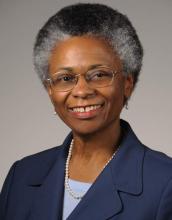
November, 2020
DR. BERNARD'S REFLECTIONS

Marie A. Bernard, MD
Acting Chief Officer for Scientific Workforce Diversity
Significant career-related barriers continue to impact members of the scientific workforce. While daunting, proactive measures are being explored to overcome these hurdles and enhance inclusivity. This month’s issue will highlight evidence-based approaches and recommendations to break down barriers by addressing workforce gaps and disparities. The findings remind us that by prioritizing inclusive excellence, we can do our part to ensure a diverse landscape within the scientific community.
Grant Writing Coaching
Grant funding disparities related to women and underrepresented groups (URGs) remain a persistent barrier within academia. Although institutional reforms may be needed, a recent study conducted by affiliates of the National Research Mentoring Network (NRMN)—a NIH-funded program that provides evidence-based mentorship and professional development programming for researchers—suggests Grant Writing Coaching programs (GCPs) geared towards early stage investigators show promise as an approach to address funding gaps. The study’s authors assessed several GCP models offered by NRMN, providing intensive coaching to postdoctoral fellows or junior faculty over 4-12 months. Of the 545 coached investigators (67% women and 61% URG), 324 submitted grant applications, and 41% of submitters received funding. R01s, the premier NIH grant that provides support for health-related research, have a relatively low URG award rate. The coached investigators submitted 74 R01 (or equivalent) research proposals, 16 of which were funded (75% women and 56% URG). This 22% award rate is higher than the overall NIH 2016–2018 success rates for new R01s. By institutionalizing similar approaches and encouraging more early stage investigators to engage with NRMN’s GCPs, we can further address funding disparities within the scientific community.
Surmounting Obstacles
Another major career-related barrier is the diminishing representation of women across the later stages of the academic medicine career pipeline—from faculty to leadership positions. To uncover the causes of the gender-disparate career advancement barriers, Zakaras and colleagues conducted focus groups among male and female junior research faculty at a premier research institution. Women and men both highlighted a challenging funding environment and a lack of institutional support as significant career advancement barriers; however, women noted additional factors including experiencing significant childbearing and childcare issues (e.g., feeling pressured to take shorter maternity leaves). In addition, most women also highlighted poor mentorship (56%), feeling undervalued by the institution (56%), and a lack of negotiation related opportunities, but no similar issues were reported by male participants. Based on the findings, the authors noted critical recommendations to address career advancement barriers for women: encourage flexible work hours and implement family-friendly policies, organize diversity training (focused on gender disparities), and provide mentorship opportunities with senior faculty.
A COVID Silver Lining?
The COVID-19 pandemic continues to impact the scientific workforce in many harmful ways, but some suggest there may be a few benefits worth preserving in our post-COVID-19 future. Data from a recent publication suggests videoconferencing has broken barriers and led to an increase in diversity at scientific conferences. Examining the attendee data of several scientific societies’ conferences, many virtual conferences this year saw multi-fold increases in the numbers of attendees (compared to in-person arrangements in previous years). In particular, there was greater participation of early career researchers and researchers from countries with low-to-middle income economies—groups with potentially fewer economic means to attend in-person conferences. Similarly, a recent perspective article focused on the positive impact of COVID-19 also argued for the benefits of videoconferencing. However, the authors also suggested that the pandemic has contributed to shifting institutional academic value systems—allowing more time to be spent on questions, meetings, and panels examining diversity within science. The challenge will be figuring out how to continue these efforts in our post-COVID‐19 future. Although the answers are currently unclear, this present moment may offer the most opportune time to start discussions about preserving the beneficial lessons learned from this pandemic.
COSWD Vacancy Announcement
I am honored to serve as the acting Chief Officer for Scientific Workforce Diversity (COSWD) as NIH searches for a permanent COSWD. We are seeking exceptional candidates for the position. This is a unique opportunity to lead and oversee NIH efforts to improve biomedical research and the Nation’s health through a more diverse scientific workforce. Please consider sharing this vacancy announcement with established members of your network. The announcement will close on Friday, January 22, 2021.
This Month’s Blog Posts
If you have not had an opportunity, please review this month’s blog posts at our website.
- Moving Forward: Mitigating the Impact of COVID-19 on the Biomedical Workforce
- The Personal Impact of COVID-19 on the Biomedical Workforce
- The Institutional Impact of COVID-19 on the Biomedical Workforce

The links above are pulled from the top news articles trending on the subject of diversity in science and technology.
The stories selected are not a reflection of the views of the National Institutes of Health.

